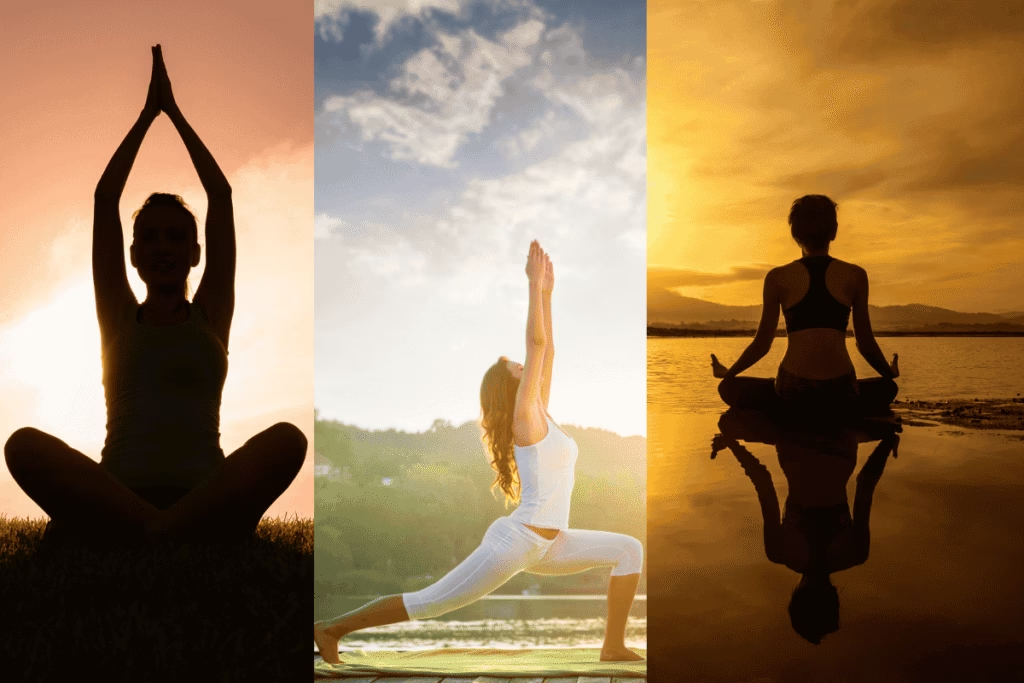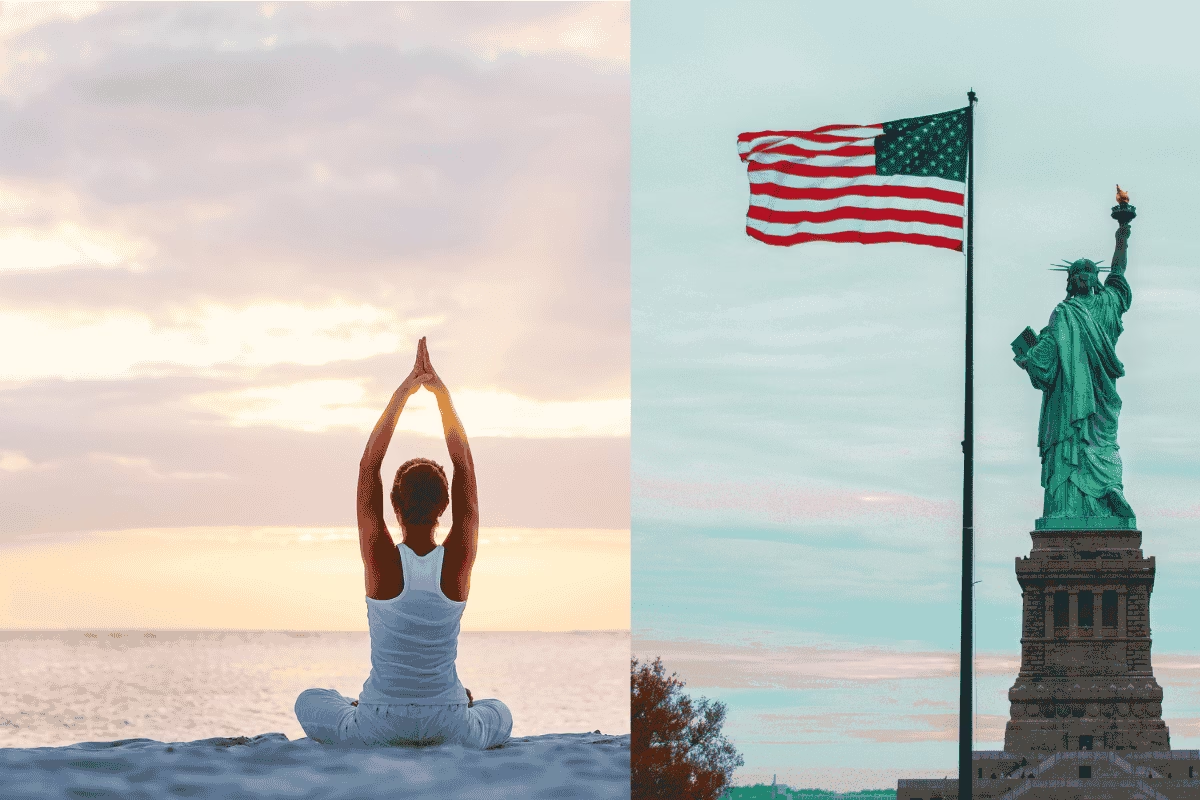Introduction
Yoga, a practice rooted in ancient Indian philosophy, has become a cornerstone of modern American wellness culture. Today, yoga studios are as common as coffee shops, and millions of Americans roll out their mats daily for peace of mind, physical health, or spiritual growth. But yoga’s presence in the U.S. wasn’t always this widespread. The history of yoga in America is one of slow beginnings, cultural evolution, and remarkable transformation.

The First Glimpse: Yoga’s Arrival in the Late 19th Century
Yoga first reached American shores in the late 1800s, thanks to the pioneering efforts of Swami Vivekananda, an Indian monk and philosopher. His groundbreaking speech at the 1893 Parliament of the World’s Religions in Chicago introduced yoga as a path to spiritual enlightenment. However, this early form of yoga focused more on philosophy and meditation than the physical poses (asanas) most associate with the practice today.
This early phase was intellectual and spiritual, resonating mostly with academics, writers, and the culturally curious. Yoga was seen as a mystical Eastern practice, not yet adopted for its physical or therapeutic benefits.
Laying the Foundation: The 1920s–1930s
The early 20th century saw more Indian spiritual leaders bring yoga to America. Paramahansa Yogananda, who arrived in 1920, popularized Kriya Yoga and established the Self-Realization Fellowship, attracting American followers interested in self-awareness and inner peace.
Another major development was the emergence of Hatha Yoga, which involves physical postures, breathing exercises, and meditation. Teachers like Krishnamacharya (in India) trained future legends such as B.K.S. Iyengar and Pattabhi Jois, who would eventually become pivotal figures in the American yoga scene.
However, during this time, yoga remained a fringe practice, confined to small spiritual groups and communities.
Hollywood and Healing: The 1940s–1950s
In the 1940s, yoga gained visibility in the West through Indra Devi, a Russian-born woman who studied under Krishnamacharya. She opened one of the first yoga studios in Hollywood and became a teacher to celebrities like Marilyn Monroe and Greta Garbo.
Devi’s approach was gentle and accessible, focusing on breath, movement, and inner calm. For the first time, American women began embracing yoga not only for its spiritual value but also for beauty, grace, and health.
This period marked yoga’s shift from esoteric philosophy to physical and emotional wellness.
The Counterculture Explosion: 1960s–1970s
The 1960s and 70s counterculture movement was the turning point. As Americans sought alternatives to mainstream religion, medicine, and lifestyle, Eastern spirituality—especially yoga—gained traction.
Major Indian gurus like Maharishi Mahesh Yogi, Yogi Bhajan, and Swami Satchidananda attracted huge followings. Yogi Bhajan introduced Kundalini Yoga, combining meditation, chanting, and breathwork. Satchidananda opened Woodstock in 1969 with a spiritual invocation.
The association of yoga with peace, freedom, and self-discovery resonated deeply with the younger generation. By the end of the 1970s, yoga had firmly planted its roots in American soil.
Yoga Gets Physical: 1980s–1990s
In the 1980s and 90s, yoga became more mainstream—and more physical. Styles like Ashtanga Yoga, Power Yoga, and Bikram Yoga entered gyms and fitness centers, offering dynamic workouts that blended strength, flexibility, and cardio.
This period saw yoga move away from its purely spiritual origins. While some purists criticized this shift, it also allowed millions to experience yoga in a new, accessible form. Celebrities like Madonna, Sting, and Gwyneth Paltrow endorsed it, and popular media began covering yoga as the ultimate lifestyle practice.
Yoga was no longer niche—it was now fashionable, fit, and here to stay.
The Wellness Boom: 2000s to Today
Today, yoga is a multi-billion-dollar industry in the United States. From boutique studios and online classes to retreats and apparel lines, yoga has permeated American culture. According to industry reports, over 36 million Americans now practice yoga, and the numbers continue to rise.
Yoga has been integrated into:
- Corporate wellness programs
- Public schools
- Professional sports training
- Mental health therapies
In the digital age, platforms like YouTube and fitness apps have made yoga even more accessible. Influencers and instructors have built massive followings, offering live-streamed sessions and virtual retreats.
Moreover, the recent years have seen a return to yoga’s holistic roots. More practitioners are exploring pranayama (breathwork), meditation, and yogic philosophy, balancing physical practice with spiritual awareness.
Challenges and Cultural Reflection
With yoga’s popularity has come debate around cultural appropriation. Critics argue that commercialized yoga in America often strips away its Indian heritage and deeper meaning. In response, many American studios and teachers are now making efforts to honor yoga’s roots, teaching Sanskrit terms, incorporating traditional philosophy, and highlighting its Indian origins.
Famous Quotes on Yoga in America
- “Yoga is not about touching your toes. It is what you learn on the way down.” – Jigar Gor
- “Yoga teaches us to cure what need not be endured and endure what cannot be cured.” – B.K.S. Iyengar
- “In truth, yoga doesn’t take time—it gives time.” – Ganga White
Final Thoughts: An Ancient Practice for a Modern World
The history of yoga in America is a story of transformation, adaptation, and resilience. What began as a meditative Eastern philosophy is now a powerful tool for physical health, mental clarity, and spiritual insight in millions of American lives.
Yoga’s journey from temples in India to yoga mats in New York is more than a cultural shift—it’s a testament to the universal need for balance, inner peace, and connection. Whether you practice for flexibility or enlightenment, yoga continues to be a timeless guide in an ever-changing world.
Please Read : Modern Spirituality: Your Path to Inner Peace


1 thought on “🧘 Yoga in America: From Ancient Practice to Modern Wellness Phenomenon”
Comments are closed.